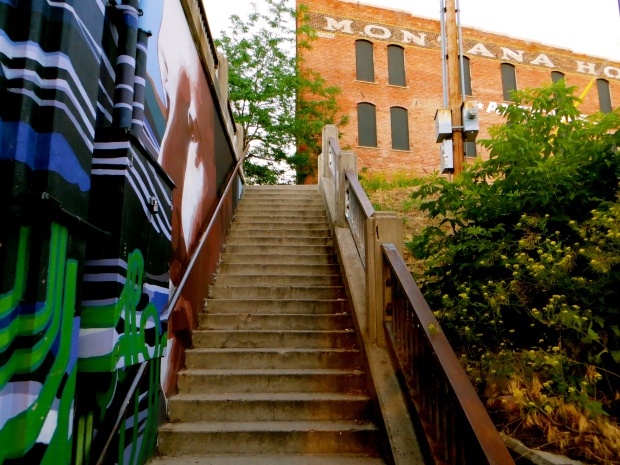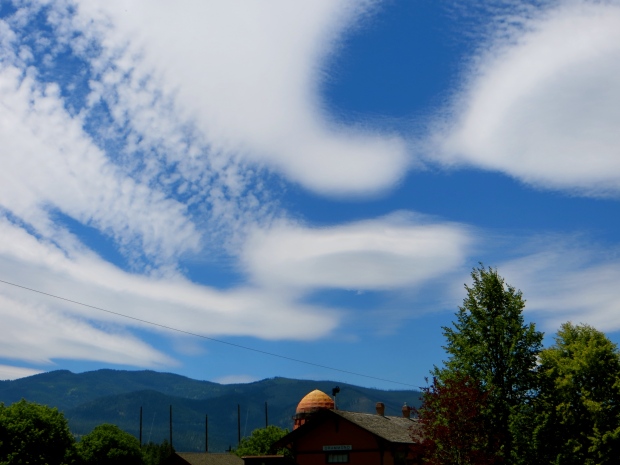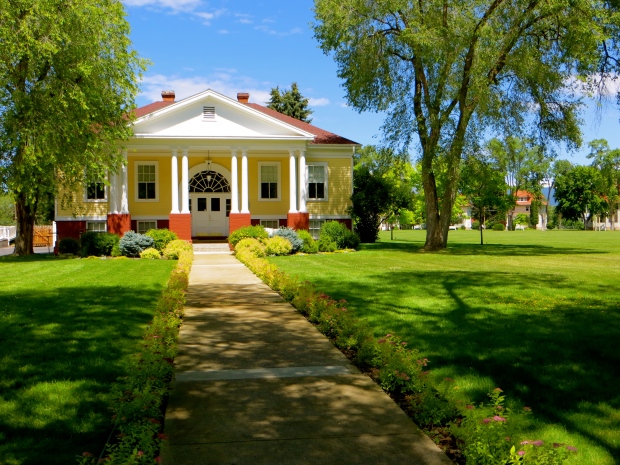Missoula very quickly cast its spell on us. Downtown ran roughly west to east along the north bank of the wide Clark Fork River. Interstate 90 lay to the north just below a ridge of hills, and between the interstate and downtown was the railroad with a marshalling yard kept busy at most times of the day. Most of the city’s residential areas spread south and west of the river and looked overwhelmingly attractive. Beyond the residential districts were the Bitterroot Mountains dominated by Lolo Peak, which was 9,139 feet high. The airport was to the west of downtown and the University of Montana occupied a substantial plot of land south-east of the river. Although downtown had a majority of Missoula’s important buildings and most interesting streets, immediately across the river from the Wilma Building was a second area of historic merit. Another must-see was Fort Missoula not far from Big Sky Park.
The best of downtown lay between the railroad to the north and the river to the south with North Orange Street marking its western extremity and Madison Street its eastern one. As in most US cities that struggled to sustain their economic well-being, there were some vacant lots in the downtown area, but Missoula had fewer than most cities of comparable size (Missoula had an official population of about 70,000). There were no skyscrapers, but some large structures confirmed that Missoula was an important urban centre, especially by the standards of Montana and its neighbouring states. Front Street, Main Street and Broadway ran roughly west to east and were overlooked by dozens of landmark structures, but north to south streets that should be seen included Higgins Avenue and Ryman Street. In fact, for anyone with the time, every block in the downtown area should be examined for the dozens of notable brick and stone buildings; the unusual shops; the old banks, hotels and churches; the interesting bars, cafes and restaurants; the old garages; the motels at the east end of Broadway; the bulky industrial and commercial buildings; the ghost signs and painted adverts; the metal signs with their 1950s’ flourishes overhanging the sidewalks; and the city’s indisputably important buildings such as the two elegant railroad stations (sadly, neither of the stations were served by passenger trains), Missoula County Courthouse and the Wilma Building. The historic area south of the river was worth examining from South 3rd Street West in the north to South 6th Street West in the south and from Chestnut in the west to Higgins in the east (there was lots of attractive houses, some of which were very large, a brewery, an ice cream parlour, a popular bakery in an old brick building and some unusual dining options other than the bakery). Between the river and South 3rd Street West was one of Missoula’s old railroad stations (the other station was beside the railroad to the north of downtown). Sadly, no tracks survived, but the building with its very tall tower had been lovingly preserved.
There was another area worth visiting. I walked north along Orange Street as if heading toward the railroad. The road dipped into what was in effect a tunnel beneath the many tracks. Once through the tunnel, a flight of steps led to North 1st Street, which was probably a part of the city that few people would have gone to in the old days. Why? Because it was the street closest to the railroad engine depot (sadly, the depot no longer existed) and was overlooked by an odd assortment of warehouses, sheds, workshops and rundown housing. Many of the original buildings had survived and most had been restored. All of them seemed to be used for residential, commercial or artistic purposes. Moreover, some delightful new buildings including apartment blocks had filled the vacant lots. With a nearby bar and restaurant serving excellent beers and good food in an old railroad building, and a theatre in one of the landmark structures along North 1st Street, this was definitely an area to visit. It was up and coming and had a great atmosphere. But there were also some interesting buildings just south of the railroad along Railroad Street. What was now the Montana Antique Mall occupied what had been an enormous hotel.
In the old days, the Wilma Building was a theatre, a cinema and a hotel. The hotel used to occupy the floors above the theatre and cinema, both of which survived (the hotel now comprised of two floors of commercial office space and five floors of condominiums).
The eight-storey Wilma Building was completed in 1921. The cinema had space for just over 100 people, but the theatre, conceived in Louis XIV style, accommodated over 1,000. The audience in the theatre could see films or watch live shows on the stage.
Nearby was the Florence Building. We were able to enter its unusual lobby because a wedding reception was in full swing in a large room on the floor above. Art moderne flourishes abounded internally and a perfectly formed art moderne passageway led from one side of the lobby. Along the passageway were small business premises in what was in effect a short shopping arcade.
It soon became apparent that Missoula had enjoyed a building boom during the 1920s because a lot of downtown structures had art moderne characteristics.













